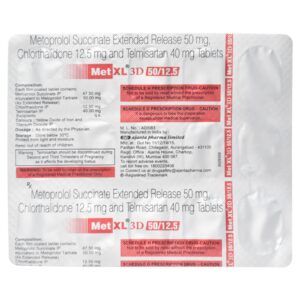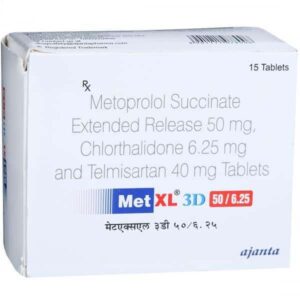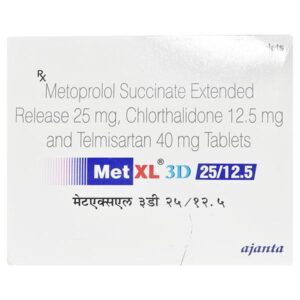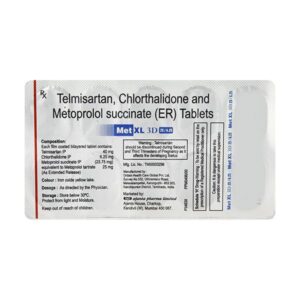CHLORTHALIDONE + METOPROLOL + TELMISARTAN
Chlorthalidone: Chlorthalidone is a medication that belongs to the thiazide diuretic class of drugs. It is primarily used to treat high blood pressure (hypertension) and to reduce the accumulation of fluid in the body (edema) caused by conditions such as heart failure, kidney problems, or liver disease.
The main mechanism of action of Chlorthalidone is to increase urine production by inhibiting the reabsorption of sodium and chloride ions in the kidney. This results in increased urine output and a decrease in the volume of fluid in the bloodstream, which helps to lower blood pressure. The diuretic effect also helps to reduce edema by removing excess fluid from the body.
The usual starting dose of Chlorthalidone for hypertension is 25 mg once daily, but this can be adjusted by a healthcare professional based on individual response and needs. For edema, the dose may be higher, often in the range of 50-100 mg daily. It can be taken with or without food.
Like most medications, Chlorthalidone can cause some side effects. The most common side effects include increased urination, dizziness, low blood pressure, electrolyte imbalances (such as low levels of potassium, sodium, or magnesium), increased blood sugar levels, and increased sensitivity to sunlight. Less common side effects may include muscle cramps, nausea, vomiting, rash, and erectile dysfunction. It is important to report any severe or persistent side effects to a healthcare professional.
In some cases, Chlorthalidone may be contraindicated or require caution in individuals with pre-existing conditions such as gout, diabetes, liver or kidney disease, or allergies to sulfa drugs. It may also interact with certain medications, including nonsteroidal anti-inflammatory drugs (NSAIDs), lithium, and certain antidiabetic drugs. It is important to discuss all current medications and medical history with a healthcare professional before starting Chlorthalidone.
Overall, Chlorthalidone is an effective medication for the treatment of hypertension and edema. However, it should only be used under the supervision of a healthcare professional, as they can determine the appropriate dose, monitor for any potential side effects or drug interactions, and ensure its safe and effective use.
Metoprolol: Metoprolol is a medication classified as a beta-adrenergic blocker, specifically a selective beta-1 blocker. It is commonly prescribed under various brand names such as Lopressor and Toprol-XL.
Metoprolol is primarily used to treat various cardiovascular conditions, including high blood pressure (hypertension), angina pectoris (chest pain), heart failure, and to prevent future heart attacks. Additionally, it is sometimes prescribed to manage certain types of abnormal heart rhythms (arrhythmias) and as a prophylactic treatment for migraines.
The drug works by blocking the effects of adrenaline and noradrenaline on the heart and blood vessels. By doing so, it reduces the heart rate and lowers blood pressure, leading to a decrease in cardiac workload. This helps to relieve or prevent symptoms associated with cardiovascular conditions.
Metoprolol is available in different formulations such as immediate-release tablets, extended-release tablets, and injectables. The dosing regimen may vary depending on the specific condition being treated, the patient’s age, and other factors. Generally, the initial recommended dose of metoprolol for hypertension is 25-50 mg once daily, and for angina or heart failure it may range from 100-200 mg once daily. The dosing schedule for extended-release formulations differs and should be determined by a healthcare professional.
While metoprolol is generally well-tolerated, it may cause some side effects. Common side effects include fatigue, dizziness, low blood pressure, slow heart rate (bradycardia), and depression. Other possible side effects include shortness of breath, cold extremities, gastrointestinal disturbances, and nightmares. It’s worth mentioning that abrupt discontinuation of metoprolol may lead to rebound hypertension or exacerbation of angina symptoms, so the medication should be gradually tapered off under medical supervision.
As with any medication, it is important to consult with a healthcare professional for personalized advice and to discuss potential risks and benefits before starting treatment with metoprolol.
Telmisartan: Telmisartan is a medication used to treat high blood pressure (hypertension). It belongs to the class of drugs known as angiotensin II receptor blockers (ARBs). Telmisartan works by blocking the action of angiotensin II, a hormone that causes blood vessels to narrow, thereby reducing blood pressure.
The usual starting dose of Telmisartan is 40 mg once daily, with the maximum dose being 80 mg once daily. It can be taken with or without food and should be swallowed whole with a glass of water.
Common side effects of Telmisartan include headache, dizziness, tiredness, and stomach pain. These side effects are usually mild and go away on their own. Less common but more serious side effects may occur, such as an allergic reaction, swelling of the face, lips, throat, or tongue, and difficulty breathing. It is important to seek immediate medical attention if any serious side effects occur.
Telmisartan is generally well-tolerated and has a low risk of side effects compared to other antihypertensive medications. However, like any medication, it may not be suitable for everyone. It is important to consult a healthcare professional before starting Telmisartan to determine if it is the right medication for you and to discuss any potential risks or interactions with other medications you may be taking.




